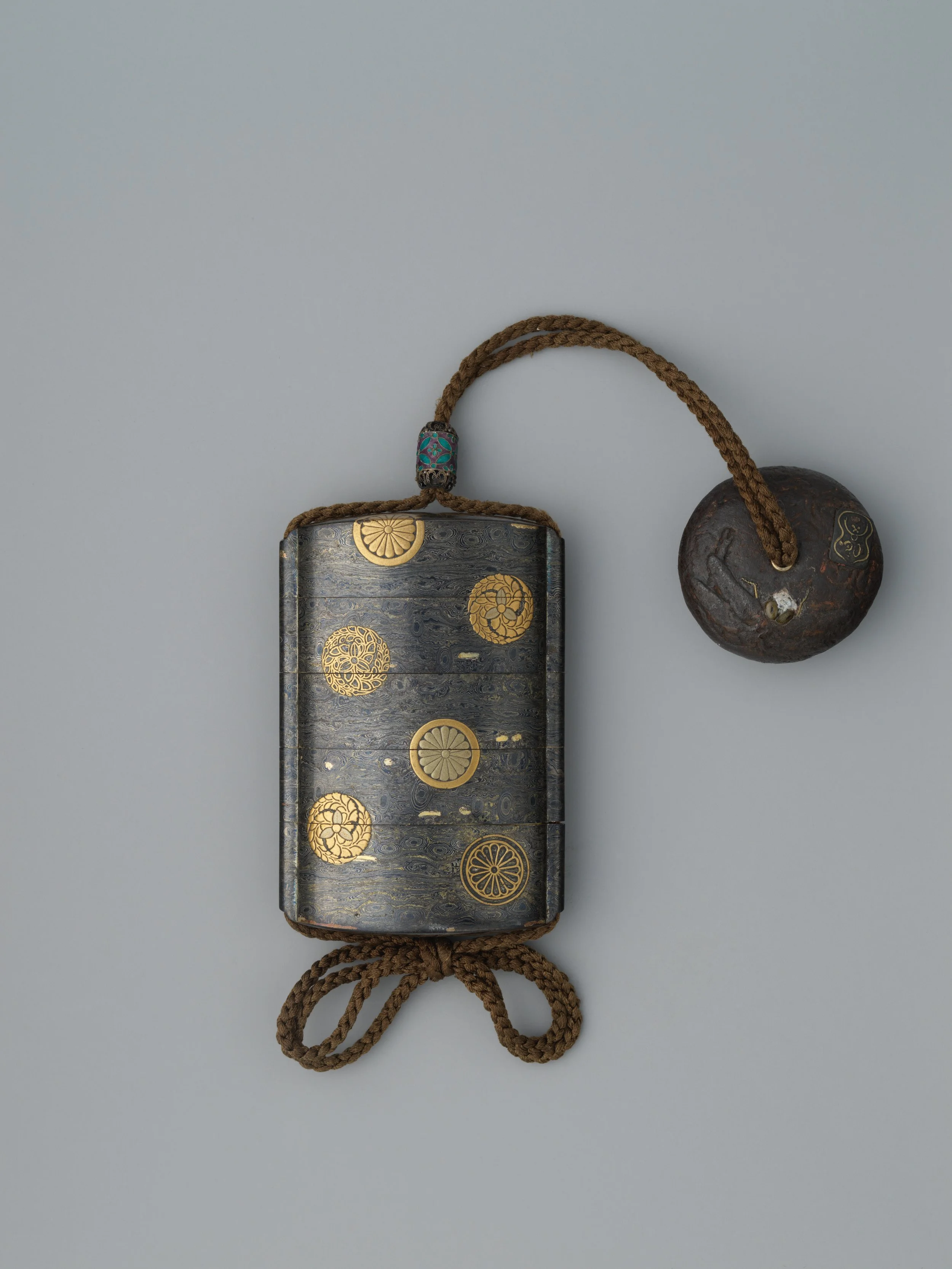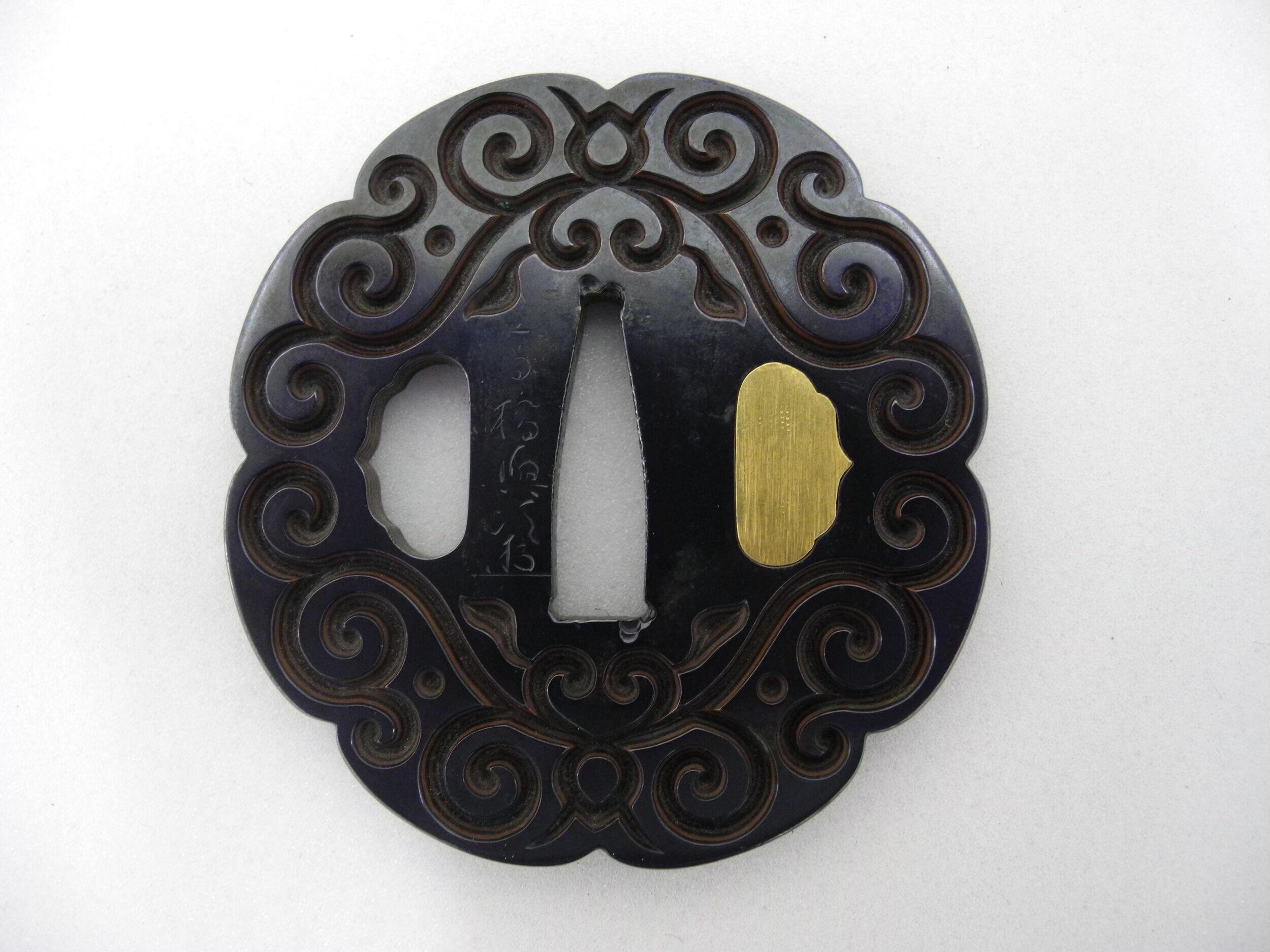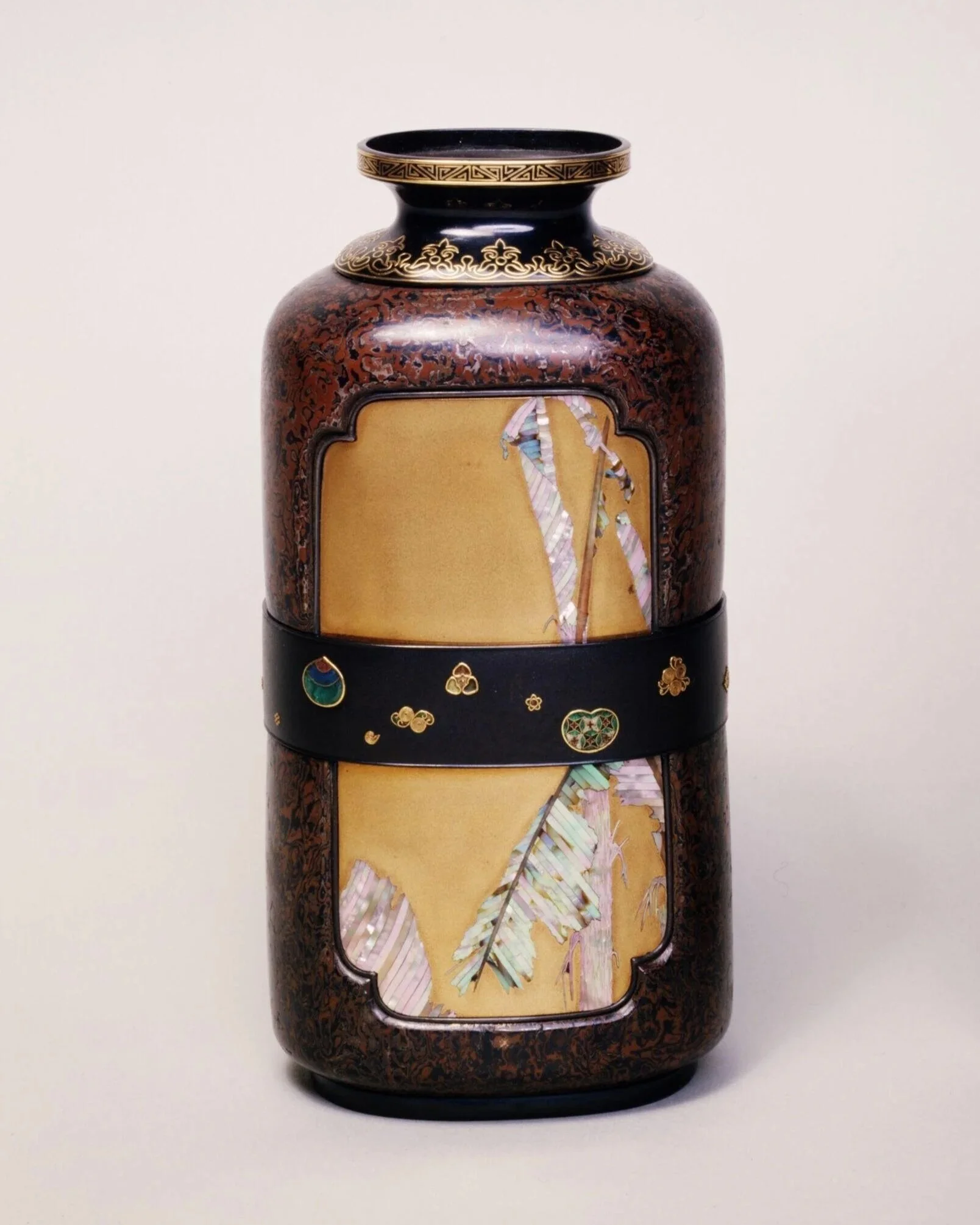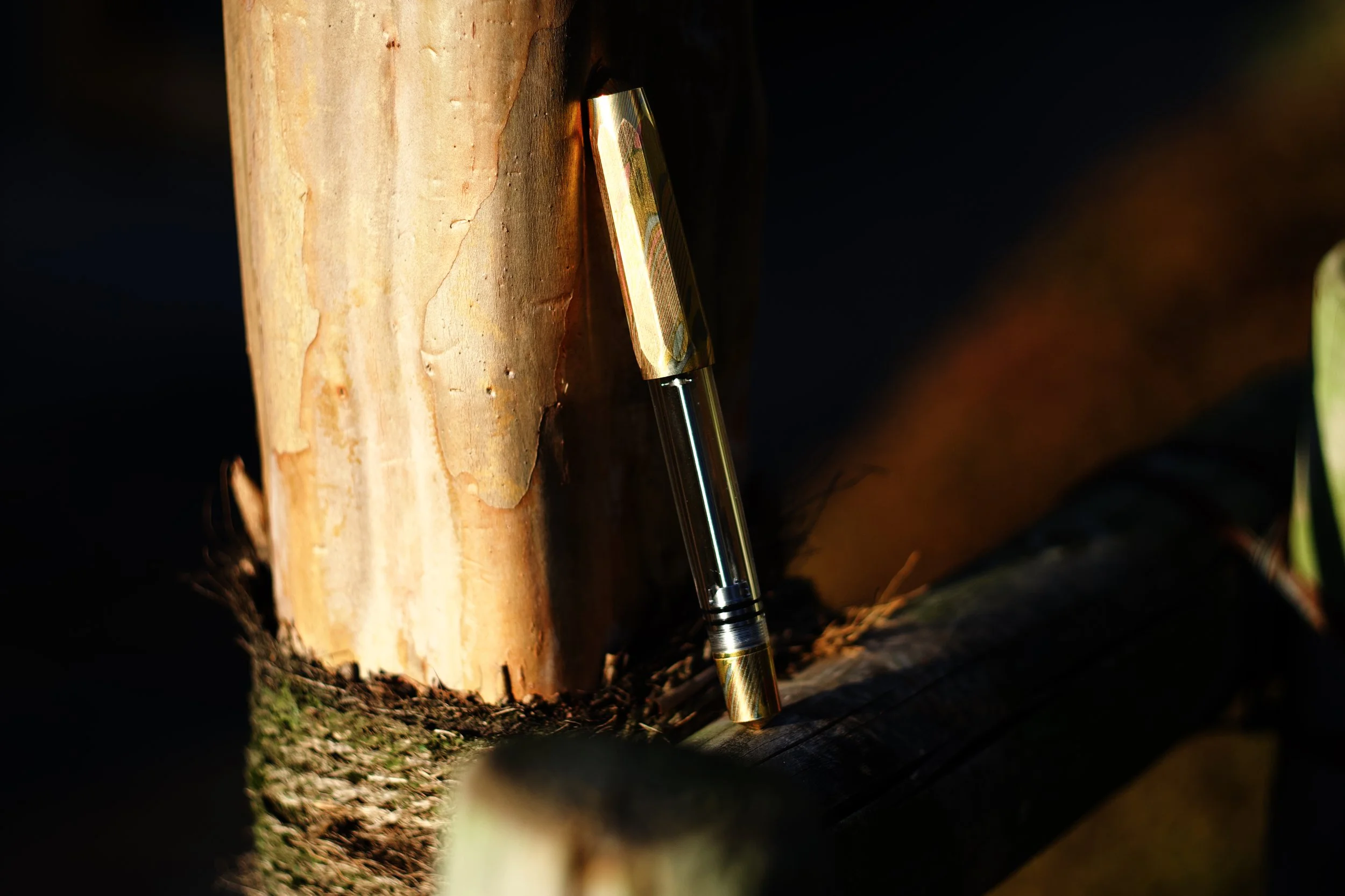The Evolution of Mokume-gane: From Japan to the West and Back Again
Left: Mokume-gane Inro, Right: Tiffany & Co. Mokume-gane Cigarette Case, The Metropolitan Museum of Art, New York.
Table of Contents:
Expansion of Mokume-gane Techniques During the Mid-to-Late Edo Period
To learn about the creation of Mokume-gane please read this article: The Origins of Mokume-gane
Mokume-gane (木目金) was first created by master sword fitting craftsman Shoami Denbei in the early Edo Period. Early examples of Mokume-gane tsuba (鍔) created by Shoami Denbei were already incredibly detailed in its execution, with a range of textures present in a single sheet of metal, hammered down after carving and twisting of the layered billet. A mixture of concentric circles and parallel lines can be seen in his tsuba and knife designs, indicating that different carving and forging techniques were already being used to create variation in the final patterns. This itself is a deliberate process that requires a good understanding of how the layers of metals would interact and transform to create these patterns once the billet is flattened into a smooth metal sheet.
While Mokume-gane was passed down from Shoami Denbei to other craftsmen during the Edo period, the most notable craftsmen in this lineage were Takahashi Masatsugu who formed the Takahashi School, and his adopted son Takahashi Okitsugu who continued working with tsuba designs using Guri bori (ぐり彫り) and Mokume-gane techniques in the mid-Edo period (19th Century).
Guri bori Tsuba by Takahashi Okitsugu, Victoria and Albert Museum, London.
It was Takahashi Okitsugu who developed the Mokume-gane technique to new heights, by incorporating picturesque designs into his carvings, which set them apart from the more organic and random patterns that were characteristic of Mokume-gane in the early Edo period.
His works were the first example of artistic intent being transmitted through the Mokume-gane technique, and opened the doors for further exploration into the possibilities of Mokume-gane as an artform to express specific motifs and images.
Takahashi Okitsugu’s Cherry Blossom and Red Maple Leaves Floating in a River tsuba designs are notable examples of how detailed and intricate designs could be expressed with Mokume-gane, and have served as inspiration for many artists who came after him as they experimented with their own Mokume-gane techniques.
During the Mid-to-Late Edo period, we can see an expansion of different Mokume-gane styles being expressed through tsuba designs from various makers. They each explored the technique in their own way, and demonstrated how distinct styles could be created out of the same fundamental material.
Mokume-gane tsuba by different craftsmen. Top Left: Mokume-gane Tsuba with Hawk and Sparrow, The Walters Art Museum, Baltimore, Top Right: Mokume-gane Tsuba, The Metropolitan Museum of Art, New York, Bottom Left: Mokume-gane Tsuba with Insect and Leaves, The Metropolitan Museum of Art, New York, Bottom Right: Minamoto Sadakazu of Naniwa Tsuba, Victoria and Albert Museum, London.
The Rapid Decline of Mokume-gane during the Meiji Period
The end of the Edo period brought in societal changes when the Haitôrei Edict or Sword Abolishment Edict (1876) banned the carrying of samurai swords in public. This soon led to the decline in sword craftsmanship, including the tsuba craftsmen working with Mokume-gane.
Up to this point Mokume-gane was primarily used in tsuba production, and the remaining craftsmen had to find other ways to incorporate this technique into other products to continue the legacy of this craft. During this period, Mokume-gane could be seen incorporated into more modern items such as decorative items, vases, tobacco pipes, and portable writing sets called Yatate.
Mokume-gane Vase, Victoria and Albert Museum, London.
Mokume-gane Box in the Shape of a Drum, Victoria and Albert Museum, London.
Mokume-gane Metal Inrō with Flower Medallions, The Metropolitan Museum of Art, New York.
Mokume-gane had also made its way to the West as Japan began to export more products overseas, where it was introduced to Tiffany & Co. head of silver design Edward C. Moore and lead silversmith Charles Grosjean, who incorporated this technique into the several pieces produced by Tiffany & Co. during the late 1800’s. Mokume-gane works by Tiffany & Co. are exceedingly rare due to the immense technical difficulty and labour needed to create these pieces.
Mokume-gane Tiffany & Co.,The Metropolitan Museum of Art, New York.
Mokume-gane Tiffany & Co. Cigarette Case and Match Case, The Metropolitan Museum of Art, New York.
Since they did not have insight into how the Japanese produced their Mokume-gane works, the pieces created by Tiffany & Co. were solder-laminated instead of diffusion bonded under heat. While it could replicate the overall aesthetics of Mokume-gane, this method would often lead to pits and delamination of parts of the material, and could affect the structural integrity of the pieces.
Since Mokume-gane requires a high level of skill and technical knowledge, it was difficult to sustain widespread production after the decline in tsuba production, and it became a dying artform until its revival in the 1970s.
Introduction of Mokume-gane to the United States
Mokume-gane was not readily accessible in the West until after the 1970s when knowledge of how to create Mokume-gane was brought over to the US by metalwork artists Hiroko Sato-Pijanowski and Eugene Pijanowski. They had come across a Mokume-gane vessel by Gyokumei Shindo at an exhibition in Tokyo which immediately captivated their attention. Hiroko Sato-Pijanowski had been interested in exploring more organic forms with metalwork, and she became determined to learn this technique under master craftsman Tamagawa Norio (designated Living National Treasure in 2010). They then started teaching and publishing research papers on Mokume-gane to help spread the knowledge and information in the West.
As their efforts gained traction in the West, this in turn led to a renewed interest in Mokume-gane within Japan, where it is now regarded as a culturally significant metalwork technique, with active efforts to research and record the history of Mokume-gane which has brought it back from the brink of extinction.
Exploration Of New Techniques and Patterns
Once the Pijanowski’s learned the traditional methods of creating Mokume-gane from Tamagawa Norio, they continued to explore new ways this technique could be adapted to create new forms of work.
The traditional alloys of copper like shakudo (赤銅) and shibuichi (四分一) were better suited to more decorative items that did not undergo frequent handling, as the colors those alloys produced were only created by a thin layer of oxidation on the surface of the metal. This layer of oxidation could easily wear away on items that were frequently handled, and therefore would risk losing its distinct patterning over time.
Before the 1970s, it was unknown whether other types of metals could be fused together to form metal laminates. With the advancement of science and knowledge of metallurgy, there was a greater understanding of the individual properties of metals and their compatibility with each other. New combinations of metal laminates such as using bronze and different types of gold alloys were developed, eventually leading to a new world of possibilities using the Mokume-gane technique. Metals like gold and platinum are more stable, retain their colors over time, and did not have the same risk of discoloration when compared to alloys like shakudo.
Other means of pattern formation were also explored through carving and twisting the metal billet in different ways. Chemical etching of the surface to create textures was also developed. This experimentation led to the further advancement of Mokume-gane, as the Pijanowski’s and their students sought to push the boundaries of what was known to be possible.
Improving Metal Bonding Through Solid State Diffusion Bonding
There are three different ways metals can be fused together for Mokume-gane without melting or welding techniques. These are solder bonding, liquid phase diffusion bonding, and solid state diffusion bonding.
Liquid Phase Diffusion Bonding
Traditionally in Japan, lamination of different metals was achieved through forge welding techniques which would have been similar to how kajiya (鍛冶屋 or blacksmiths) created blades. Forge welding requires a charcoal forge or a gas kiln, which enables fusing of the metal sheets in an oxygen-free environment. This method of forging requires a certain level of experience when working with different metals as the metal billet needs to be removed at the “sweating” point and further heat forged to fuse the layers for successful lamination to occur. This is not only extremely difficult but can lead to a high failure rate if the conditions are not perfect.
This method is now known as liquid phase diffusion bonding, where the different metals begin to form an alloy at the point of contact which liquifies at a specific temperature and fuses the layers together. If the billet is taken out at the wrong time, the layers can end up fully melting instead of fusing, ruining the entire billet.
Solder Bonding
Solder bonding joins two layers of metals together using a filler metal with a lower melting point than the original two metals. The solder metal acts as a glue to adhere the metal sheets together, forming a laminate structure.
This method was primarily used in the West during the 1800s-1970s, since there was no clear knowledge of how Mokume-gane was traditionally produced within Japan. It was assumed that the only way to form these laminate structures was through soldering, and therefore pieces produced in the West were limited to this technique which often led to inclusions and delamination within the metal structure. The bond between the solder material and the metal layers were also prone to stress failure during formation of the Mokume-gane patterns, leading to high rates of failure and time consuming repairs.
It was only when liquid phase diffusion bonding technique was brought to the US that enabled metalsmiths to shift away from solder bonding and use diffusion bonding techniques with higher rates of success.
While liquid phase diffusion bonding was an improvement over solder bonding, it was still very challenging and difficult to get a 100% success rate. It requires a high level of skill to determine when the billet should be taken out of the forge before the metals melted together. Furthermore, access to a charcoal forge or gas kiln was not practical, as many jeweler’s workspaces used electric kilns instead.
Solid State Diffusion Bonding
Solid phase diffusion bonding is a process where metals are fused through diffusion of metal atoms under heat and pressure. The difference between solid phase and liquid phase diffusion is the temperature and duration the billet is heated to. In liquid phase diffusion, the layered metal stack is heated to the lowest melting point of the alloy formed between the two layers of metal, which then liquifies and flows between the gaps of the two layers to fuse them together.
The first part of this breakthrough was the development of torque plates to increase the pressure applied to the metal sheets. This increased the contact points between the metal sheets, greatly improving the success rate of fusion between the sheets.
In solid phase diffusion, the layered metal stack is heated to a temperature just below the melting point, which allows for the diffusion of the metal atoms across the layers to form crystal structures that bond the layers without forming a liquid state. This is a much slower process than liquid phase diffusion, but results in a higher percentage of success due to a better control over the temperature the bond is formed at.
After several failed attempts by others in the 1970s to adapt the diffusion bonding technique to the electric kiln, metalsmith James E. Binnion embarked on a series of experiments to develop a method that would work using an electric kiln.
A major hurdle to overcome was the presence of oxygen in the electric kiln. Oxygen is detrimental to the fusion process as it reacts with the surface of the metal to form metal oxides, which prevents the layers from fusing together. This was not a problem in charcoal forges or gas kilns as the oxygen would be completely absent in those environments.
Through many rounds of failure and adjustments, James eventually found a method that worked to prevent oxidation of the metals, and was able to use this method to bond different metals including alloys of copper, gold, silver, iron, platinum and palladium. He shared this information in the 1980s with other metalsmiths, which greatly contributed to the advancement of technology behind Mokume-gane fabrication with a relatively high rate of success compared to more traditional methods.
The Revival of Mokume-gane In Japan
The efforts to revitalize the art of Mokume-gane in the West led to a renewed interest within Japan. Mokumeganeya is a jewelry company specializing in the Mokume-gane technique to create wedding rings and other types of jewelry. The founder, Masaki Takahashi, also set up a non-profit organisation in 2003 dedicated to studying historical artefacts, replicating historical works to understand the process, and promoting education about Mokume-gane within Japan and abroad.
Contemporary artists like Ryuhei Sako who is a member of the Japan Kōgei Association, has developed his own unique style with Mokume-gane, and continues to push the boundaries of what can be created with this craft. Much like how Hiroko Sato-Pijanowski was inspired by the Mokume-gane vessel created by Gyokumei Shindo, Ryuhei Sako first came across Mokume-gane through Tamagawa Norio’s work and was inspired to further study this artform. He is now regarded one of the best Mokume-gane artists in his 40s and has demonstrated his mastery over the pattern formation and manipulation of colours in a way that has not been seen in earlier generations.
Mokume-gane vessels by Sako Ryuhei. Left: Tea Caddy, Right: Hammered Flower Vase. Victoria and Albert Museum, London.
The Future Of Mokume-gane
It is sombering to consider that Mokume-gane was so close to being lost forever, and that it was seemingly only through chance and the dedicated efforts of several key artists outside of Japan that it is now recognized as an important traditional craft. Even so, it still took several decades for the accumulation of knowledge and development of new technologies to bring Mokume-gane back from the brink of extinction. Unfortunately this is the reality that many traditional crafts face, with a similar risk of disappearing as it struggles to keep its relevance in the 21st century.
While there are many artists outside of Japan who are actively working with Mokume-gane, there are still only a few artists within Japan who have been able to fully embody the craft and create something completely unique out of it. Yet there is now a renewed hope that this craft will continue to reach new heights in the future, as the techniques are passed down to the next generation where new innovations and ideas can be realized.
View Our Related Products:
ADDITIONAL Resources:
NPO Japan Mokumegane Research Institute:
https://www.mokumegane.org/e/
Textbook of Mokume-gane:
https://www.amazon.com/Textbook-Mokume-gane-Masaki-Takahashi/dp/4990498216/
Hiroko Sato-Pijanowski’s Website:
https://www.hirokosato-pijanowski.com/
Living National Treasure Norio Tamagawa:
https://www.gyokusendo.com/en/library/mokume
Sako Ryuhei:
https://www.sakoryuhei.com/
https://www.instagram.com/ryuheisako/
Websites About Mokume-gane:
https://www.mokume.com/
https://www.metmuseum.org/perspectives/metalworking-mokume-gane
https://mokume-gane.com/
Electric Kiln Diffusion Bonding:
https://www.santafesymposium.org/2002-santa-fe-symposium-papers/2002-old-process-new-technology-modern-mokum-gane
https://www.mokume.com/mokume-gane-a-comprehensive-study/electric-kiln-fired-mokume-gane-by-james-binnion
Diffusion Bonding Techniques:
https://www.mokume.com/mokume-gane-a-comprehensive-study/2metallurgical-theory-for-mokume-gane-rings-and-jewelry
https://www.mokume.com/mokume-gane-a-comprehensive-study/mokume-gane-basics-how-to-for-rings-wedding-bands-and-vessels
Other Mokume-gane Resources:
https://www.mokume.com/mokume-gane-a-comprehensive-study/table-of-contents


















